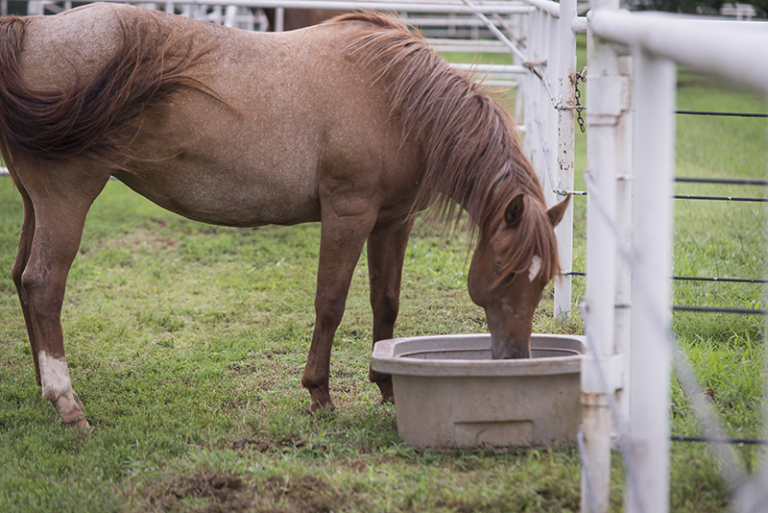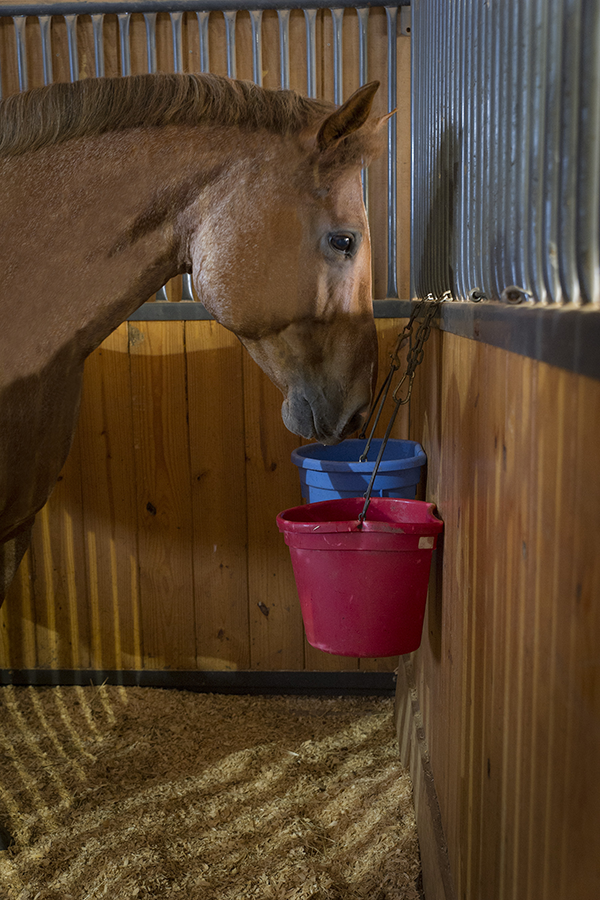Water: The Most Important Nutrient
The most important nutrient in your horse’s diet may be the most overlooked.  Providing horses with water may seem obvious, so may not seem to even warrant discussion.
What do you really know about how much your horse should be drinking per day?
Providing horses with water may seem obvious, so may not seem to even warrant discussion.
What do you really know about how much your horse should be drinking per day?
The amount of water a horse needs to consume per day is directly related to how much
water the horse loses per day. Horses lose water mainly through their manure, urine,
sweat, respiration and for a broodmare, through lactation. All of these variables
must be taken into account when determining how much water horses should be drinking.
When these losses increase due to variations in diet, work or environment, the horse
must be allowed greater access to water. Sometimes that may mean owners need to be
creative in encouraging the horse to consume more water.
One of the greatest water losses to a horse is manure, and is often overlooked. While we tend to think of it as a rather solid form that must continually be scooped, picked up or shoveled; horse manure, by weight, is mainly water. This is especially true if the horse is eating primarily roughages. On an all forage diet, horse manure contains as much as 72 percent to 85 percent moisture. In fact, the water lost through manure may represent almost 60 percent of a horse’s daily water intake. If the horse is switched to a grain-based diet, the manure actually becomes much drier. Overly dry feces can lead to impaction colic, therefore must be avoided. When a horse consumes forage, it is digested through fermentation, which requires normal gut health. The hind gut of the horse is actually a fairly liquid environment that allows for optimal bacterial growth. Consumption of forage encourages water intake to maintain this environment, and in part, this is why it is recommended to provide at least 1 percent of their body weight in forage per day.
Variations in diet beyond just forage versus grain, can influence water losses in horses. The total amount of feed the horse eats will alter its water requirements. As consumption of feed increases, the horse must consume more water to allow normal digestive processes to occur. While forage does increase water losses, thus water intake, the type of forage the horse consumes is also a factor in its water needs. Fresh pasture grass contains a much higher moisture content compared to dry feed, which is typically only 10 percent to 15 percent moisture. In comparison, growing grass may contain as much as 80 percent moisture. When taking into account the total amount of grass a horse can consume, simple grazing may approach a horse’s basic water requirements. It is not surprising that horses will visit the water trough less frequently while grazing lush forage compared to when being fed hay.
Urine obviously contributes to water losses in horses, but the volume of urine may reflect the overall water balance in the horse. Urine actually represents the most variable water loss in the horse, as other losses are more directly tied to diet, metabolic demands and environment. Some horses simply consume more water than others so will excrete more dilute urine to rid the body of excess water. Alternatively, if the horse’s water needs are not met, the kidneys will act to limit water losses and concentrate the urine. Additionally, if the feed contains components that need to be excreted by the kidney, water losses will increase. For example, when horses are fed protein beyond their requirements, the carbon skeletons of the extra amino acids are broken down into components that can be used for fuel. This process involves the removal of the nitrogen found in amino acids. The liver incorporates the excess nitrogen into urea, which is then excreted by the kidney through the urine. The urea content in urine, which is broken down to ammonia by bacteria, is what creates the smell associated with poorly ventilated buildings. Excess electrolytes, in particular sodium and potassium, must also be excreted through the urine. If a horse likes to consume salt at a greater rate, its’ stall may be wetter than horses that do not consume as much salt. For horses that do overconsume salt, it may be best to limit intake to their daily requirement.
Sweat represents a tremendous variable in water losses for the horse, dependent on
 both temperature and exercise. Compared to other species that rely primarily on respiratory
cooling or panting to cool themselves, horses are most similar to humans as both dissipate
heat through sweating and evaporative cooling. As horses must breathe through their
nostrils, panting is simply not an option for them. Increasing the environmental temperature
can increase evaporative losses between 45 percent to almost 400 percent of the horse’s
normal water losses. The addition of exercise on top of environmental losses can quickly
lead a horse to dehydration and heat stress if water losses are not replenished. For
example, cross country horses have been reported to lose as much as 50 pounds to 75
pounds of water during a competition, due to the sustained duration of activity. Respiratory
water losses are also directly tied to temperature and work load as these have the
greatest influence on respiration rate. Horses increase respiration rate, either to
aid in cooling, or due to the increased demand for oxygen delivery to the muscle tissue.
Remember though, relative to sweating, respiratory losses are relatively minimal.
both temperature and exercise. Compared to other species that rely primarily on respiratory
cooling or panting to cool themselves, horses are most similar to humans as both dissipate
heat through sweating and evaporative cooling. As horses must breathe through their
nostrils, panting is simply not an option for them. Increasing the environmental temperature
can increase evaporative losses between 45 percent to almost 400 percent of the horse’s
normal water losses. The addition of exercise on top of environmental losses can quickly
lead a horse to dehydration and heat stress if water losses are not replenished. For
example, cross country horses have been reported to lose as much as 50 pounds to 75
pounds of water during a competition, due to the sustained duration of activity. Respiratory
water losses are also directly tied to temperature and work load as these have the
greatest influence on respiration rate. Horses increase respiration rate, either to
aid in cooling, or due to the increased demand for oxygen delivery to the muscle tissue.
Remember though, relative to sweating, respiratory losses are relatively minimal.
The good news is that horses, through training or adaptation to their environment, do become more efficient at heat dissipation and begin to minimize their water losses. However, full acclimation to increased environmental temperatures may take up to three weeks. While it would be ideal if weather patterns would gradually increase through time, allowing horses to adapt, this is simply not reality. Therefore, when the temperature gauge rises dramatically, or even sporadically, horses may not easily be able to dissipate heat because their bodies have not had sufficient time to acclimate. This will require more caution when working horses during abrupt changes in temperature.
Lactating mares also have a significant loss of water through the milk. The amount of milk produced can be extremely variable between mares, with an average of 2 percent to 3 percent of their body weight per day. This will increase their water requirements somewhere between 50 percent and 75 percent more than their normal requirements. Lactating mares also have a very high energy demand on their bodies, which increases their feed intake as well. Remember — as feed intake increases, the horse must increase their water consumption to maintain digesta flow, and to counter the losses of water through the manure.
So what does all of this mean relative to what needs to be offered to horses? Basic recommendations are to always allow the horse free access to clean, fresh water beyond what they are willing to drink. In general, a 1,000-pound horse will consume around 10 gallons of water per day. This is easily accomplished by offering two full 5-gallon buckets twice a day. However, if the bucket is empty when it is time to refill it, consider hanging an additional bucket to optimize water intake.
Kris Hiney
Extension Equine Specialist
